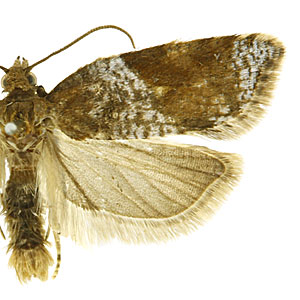Adult Recognition

FWL: 5.0-8.5 mm
Seven forms or aberrations have been described, many of which are identical in appearance to other Acleris species such as A. laterana and A. extensana. Wing pattern among the different forms varies considerably, but all have a dark triangular costal patch which ranges in color from brown to red to black. The general form of the male genitalia is sufficient to place individuals in the A. comariana/laterana complex. Female genitalia are less diagnostic but A. comariana has a much reduced signum. Males lack a forewing costal fold.
Acleris comariana is most closely related to A. laterana, which is referred to as the synonym A. latifasciana in many publications. Because Sheldon (1925) described many of the A. comariana forms using names identical to Acleris species names, literature discussions of differences in species and forms must be carefully followed to avoid confusion.
Razowski (2002) illustrates differences in genitalia that can be used to separate A. comariana from other closely related European Acleris.
Larval Morphology

Early instar larvae are white with a black head, prothoracic shield, and legs. Abdomen color varies in later instars, but all have a darker subdorsal line and conspicuous brown pinacula. The head is yellowish brown along with the prothoracic shield, which has a dark brown or black posterior margin.
Larvae of A. laterana can be distinguished from A. comariana by the dark brown to black posterior margin of the prothoracic shield, which has two subdorsal spots in A. laterana, and brown pinacula with are concolorous with the abdomen and not conspicuous in A. laterana. Acleris laterana has not been recorded from North America.
Biology

Acleris comariana completes two generations in Europe, with adults present from mid-June to July and again from late August to early November. This species prefers wetlands and bogs where many of its host plants occur.
Females deposit eggs on lower parts of the plant, usually on the stipules or petioles. Eggs from the first generation hatch in approximately 10 days; those of the second generation turn a reddish color and hatch the following spring. Larvae feed inside tied or folded leaves although they may also feed on flowers of some hosts. In strawberry, flower-feeding causes distortion of fruit or prevents it from developing. Pupation occurs in a cocoon that is constructed in a rolled leaf or between the stem and petioles.
Host plants
Acleris comariana feeds on a variety of plants in the family Rosaceae. Records of A. laterana (= latifasciana) on azaleas and rhododendron (Ericaceae: Rhododendron L.) from continental Europe are thought to actually refer to A. comariana.
| Family | Genus/species | Common name |
| Ericaceae | Rhododendron L. | rhododendron |
| Rosaceae | Comarum L. | comarum |
| Rosaceae | Comarum palustre L. | purple marshlocks |
| Rosaceae | Crataegus L. | hawthorn |
| Rosaceae | Fragaria L. | strawberry |
| Rosaceae | Fragaria vesca L. | woodland strawberry |
| Rosaceae | Geum L. | avens |
| Rosaceae | Geum rivale L. | purple avens |
| Rosaceae | Malus pumila Mill. | paradise apple |
| Rosaceae | Malus toringo (Siebold) Siebold ex de Vriese | toringo crab |
| Rosaceae | Potentilla L. | cinquefoil |
Distribution

In the Palearctic, A. comariana is widely distributed across Europe to China and Japan. It is also found in Canada and has been presumably introduced into the United States (Washington) and New Zealand.
References

Bradley, J. D., W. G. Tremewan and A. Smith. 1973. British Tortricoid Moths - Cochylidae and Tortricidae: Tortricinae. The Ray Society, London, England.
Dugdale, J. S., D. Gleeson, L. H. Clunie and P. W. Holder. 2005. A diagnostic guide to Tortricidae encountered in field surveys and quarantine inspections in New Zealand: Morphological and molecular characters. National Plant Pest Reference Laboratory. 161 pp.
Obraztsov, N. S. 1963. Some North American moths of the genus Acleris. Proceedings of the United States National Museum. 114: 213-270.
Razowski, J. 2002. Tortricidae of Europe, Vol. 1, Tortricinae and Chlidanotinae. Frantisek Slamka, Slovakia. 247 pp.
Sheldon, W. G. 1925. Peronea comariana Zeller, and its variation. Entomologist. 58: 281-285.
Turner, J. R. G. 1968. The ecological genetics of Acleris comariana (Zeller) (Lepidoptera: Tortricidae), a pest of strawberry. Journal of Animal Ecology. 37: 489-520.








